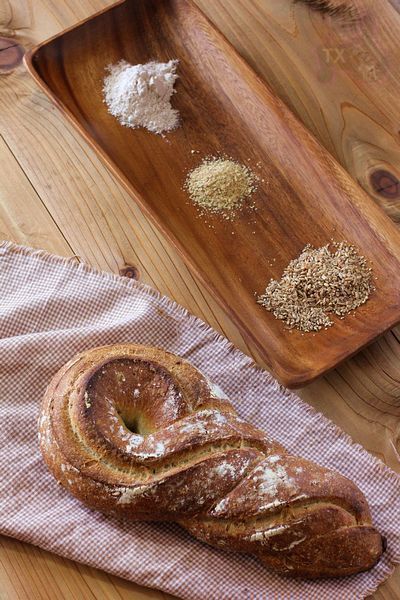
This recipe is from "Advanced Bread and Pastry". Using white and whole wheat flour, wheat germ, and cracked wheat (aka. bulgur, my new favorite bread ingredient), the bread is super fragrant and packful of flavors. I wanted to convert the formula to use sourdough, but was busy preparing for and running a half marathon last weekend, so stuck to the poolish version in the book.
In my last post, I tried some interesting shapes for baguette, this time, I tried another shaping method from the same site, you can find the video here.
Pain Meunier (adapted from "AB&P")
note: makes 2 lb loaves
-- poolish
bread flour, 241g
water, 156g
salt, 3.5g
yeast, 1/4tsp
1. mix and leave at room temp for one hour, put in fridge overnight
-- soaker
cracked wheat (bulgur), 57g
water, 57g
2. soak for at least 2 hours, I did overnight
-- final dough
bread flour, 202g
ww flour,21g
wheat germ, 11g
water, 153g
salt, 3.5g
all poolish
all soaker
3. mix together everything but soaker, autolyse for 30min, mix at low speed for 1 min, midium speed for 3min. Add soaker, mix at low speed until blended in.
4. bulk rise for 1.5hours (25C) until double, S&F at 40min.
5. divide into two parts, preshape into oval, rest for 20min, shape according to instruction here
6. proof seam down on parchment paper for 50min (25C)
7. flip the bread so it's seam side up, and bake @ 450F for 40min, with steam for the first 15min.
Really like how the shape turned out
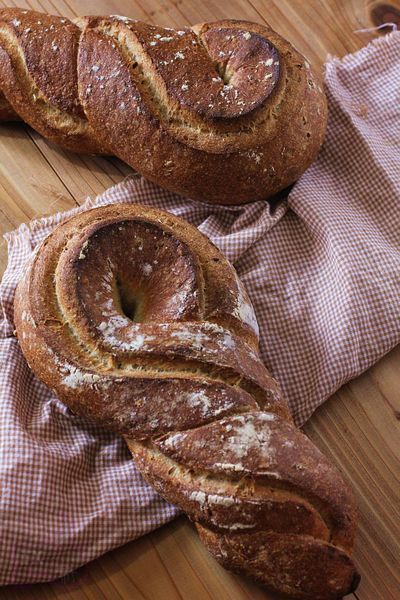
Thought all the rolling and twisting would affect the crumb, but what a pleasant surprise, full of holes and very open for a 66% hydration dough (not counting water in the soaker).
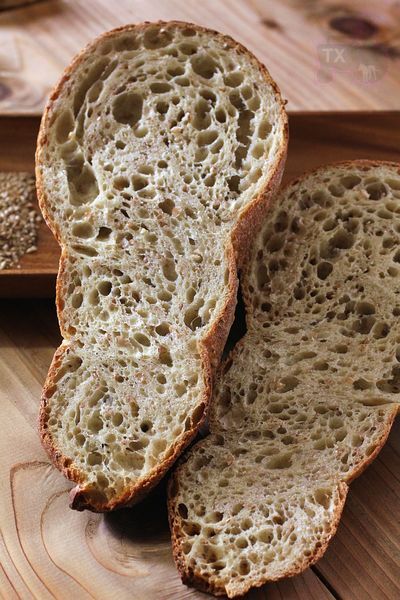
Flavor is out of this world, I REALLY like the combo of ww and cracked wheat. For my sandwich loaf, I soaked crack wheat in hot water(about 2 hours), this time in cold water (overnight), I can't really tell the difference. Both method soften the grain without turning them into mush.
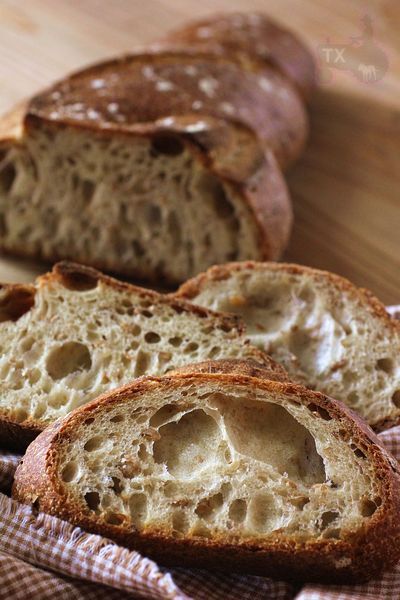
Plan to make this one again very soon, probably a sourdough version. Oh yeah, the half marathon went well too. I finished in 1:45, crossing the finish line with my running partner, very good race.
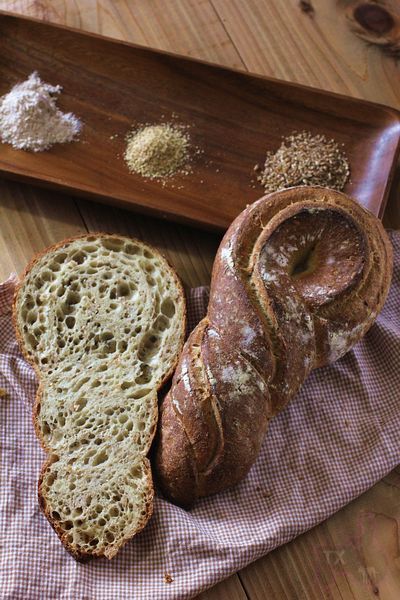
Submitting to Yeastspotting.
- txfarmer's Blog
- Log in or register to post comments
That is so beautiful, TXFarmer. Would you mind if I featured it on the home page for a bit?
I am honored!
I think I'm going to try this bread out. In your post I think you mentioned that you'd like to try a sourdough version. I read in the BBGA Bread lines about a walnut levain that contains a fermented soaker. I think they added the "sour seed" at 10% of the weight of the cracked wheat and let it ferment 12 hours. Seems like it might be interesting to try that out with this formula. Naturally fermented cracked wheat soaker and a yeasted poolish. How do you think the yeast quantity should be adjusted if I were to try this out?
Patrick
I have never used a "sour seed" before, so can't advise on how to adjust the yeast amount. I would keep the yeast amount the same for now, and keep a close eye during fermentation, then go from there.
Some formula that Txfarmer. Great bread, indeed
Best wishes
Andy
Thanks Andy, this is a keeper for sure.
Too pretty to eat.
Ha, never! We already ate one loaf. :)
What a great looking loaf txfarmer! It has a very wholesome look to it.
Is your Bulgar from Bob's Red Mill?
Do you have trouble running the videos from that site? I have to launch it and leave for 20 minutes while it finally loads.
Eric
Thanks Eric. I got mine from Central Market (an organic grocer in TX) bulk food section, the label says "cracked wheat(bulgur)".
The video indeed was very slow to load. I actually launch and go make a bread before checking back.
I have found these videos to be served at only a little above dial-up speed. That's ridiculously slow; twenty minutes or more to download a one to two minute video. My solution is to download to disc, then view the local copy in an flv viewer. I use [url=http://www.ant.com/video-downloader]Ant's downloader/viewer[/url], available for Firefox and IE.
cheers,
gary
That's just awesome!
Thanks arlo!
The shape to inspire kings!
Press and press and twist, Press and press and twist. Lovely! (great video addition)
The shape is actually one of many variations on "fendu" I think, the surprising part is that all the rolling and pressing and twisting didn't harm crumb that much.
It reminds me of a royal sceptre. Just beautiful txfarmer!
Syd
It is like a royal sceptre huh? Thanks!
Beautiful bread. I look forward to trying it.
I did have a quick question. Did the original version of the formula (AB&P) call for cracked wheat or bulgur? Bulgur and cracked wheat aren't the same thing. Cracked wheat is simply that - cracked grains of wheat. Bulgur is wheat too, but it has been partially pre-cooked. I suspect the bread would be terrific with either, though different, and I'm intrigued.
I am aware of the difference, however, bulgur is often also called "crack wheat", which is confusing. In this case, the book says "cracked wheat", but only calls for a cold soak for 2 hours (to overnight), which makes me think it's bulgur. Either way, it's going to work.
I have been reading the comments on cracked what and bulgur - and wondering why they need to be soaked? I always add either bulgur or steelcut oats to my sourdough boules and hadn't ever heard or thought of pre-soaking them. Maybe the overnight refrigeration softens them enough? They are visible in the crumb but not at all crunchy. Any ideas? A.
Bulgur absorbs a lot of water (for this formula, by the end of the overnight soaking, all water was absorbed), slowly, which means if you add them directly in the dough, the dough would seem wet enough at first, but slowly become too dry as bulgur absorbs water. The same applies to other seeds like oats, flaxseeds. Pre-soaking can help gauging appropriate hydration level during dough mixing.
In addition soaking also helps soften the grain. This bread uses poolish, and only takes about 4 hours to make, which might not be enough for the bulgur grain to soften.
Thanks, txfarmer, I'll try soaking the 1/4cup of bulgur next time, A.
Thanks for the link, too! Very nice video collection.
David
Thanks David!
Amaizing, Txfarmer.. the relentless persuit of perfection..! This is truely a piece of art,, thanks for posting..!
Thanks! This was supposed to be a "quick loaf", but what a pleasant surprise I got!
txfarmer, I noticed in the book, the final dough calls for a small amount of malt. It isn't specified in any of the mix formulas. I'm guessing you didn't use it. The coloring in the crust certainly doesn't need any more richness, it's almost red as it is.
Eric
Ha, the malt is only listed in the "total formula", so I didn't even see it until now, which means I didn't use it. Good catch!
I don't have the original recipe. How much malt does the recipe call for? Thanks!
What a beautiful loaf! What an inspirational loaf and video! Thanks for sharing!
Sylvia
Thank you Sylvia!!
This would be a fun shaping method for making cinnamon bread for the kids, or even arrange several in a star (points outward) and the center piece round (or missing ...like a wreath). Someday...
Beautiful bread though, and thanks for sharing. I'm going to try making it soon. Planned on it this weekend but was just too busy with my daughter's birthday (and 10 giggly-girl party ...all of them 13 years old plus or minus, plus one boyfriend).
Brian
收藏这个网站很久了, 在新浪关注你的微博发现图片好眼熟,才发现这边的文章也是你发表的,,
Looks really great and I really want to try it.
I have a couple questions though-did you put salt in the poolish? This is how it looks to me in your formula? And also if you autolyse you are not supposed to have salt in it either, or am I wrong here?
Sorry, for my questions. it is probably clear to everyone else lol
Salt in poolish is to control poolish's rising pace.
In the strict sense, autolyse is done without salt since salt tightens gluten. It should also done without yeast to avoid over rise. However when yeast is in the poolish, we have to add it to the dough to get the right hydration, so we comprise and allow the yeast in poolish to be added in the dough during autolyse. Same thing with salt. While it does tightens the dough to some degree, when necessary, we can add it during autolyse without too much troulbe. Tell you the truth, a lot of times I get lazy and just dump everything together to autolyse. Can't really tell a difference so far. There must be a difference, but with bread baking, there are so many variables anyway, this one thing won't be the deal breaker.
Thank you so much for the explanation
Now I have yet another question. About the poolish again. Whenever I made poolish it usually calls for the same amount of water and flour. So would this in your formula be a biga then? I am confused lol
While poolish is often 100% hydration, I have seen it in other ratios as well. The definition of those terms vary from baker to baker. AB&P calls this poolish, so I am not arguing. ;)
Thank you so much for the explanation
Now I have yet another question. About the poolish again. Whenever I made poolish it usually calls for the same amount of water and flour. So would this in your formula be a biga then? I am confused lol
The only difference between a poolish and a biga is the hydration, right? (Sorry if this hijacks the thread). As far as I know, I haven't seen any difference in say, the temperature or time or ingredients otherwise, so it's just the hydration??
Brian
Short answer yes. For a longer and more involved discussion: http://www.thefreshloaf.com/node/2784/biga-v-poolish
I concur ...thanks! I read the whole other thread and have the 2 links for more homework yet. Will read as time permits... but I'm at work!
Brian
so much for your answers
Thanks for the recipe and detailed instructions. BTW, those are nice photos and they convinced me to give your bread a try. In fact, I placed an order last night with Bob's Red Mill so I'll have all of the ingredients.
What does S&F in step 4 mean? Thanks
Ari
stretch and fold
I'm going to give this a shot this weekend. What does the stretch and fold step accomplish?
Ari
S&F accomplishes the same thing as kneading - to increase dough strength, but unlike kneading, it can keep an open crumb.
Thanks for the explanation. I thought it might have meant shape and form but didn't make sense in light of continuing the rise
Ari
I don't have the original recipe. How much malt does the recipe call for? Thanks!
and now I finally have to answer to my question what to do with the bulgur I bought a while ago. What an interesting and great looking bread, txfarmer!
I'll add that to my recipe collection and try it out soon.
Karin